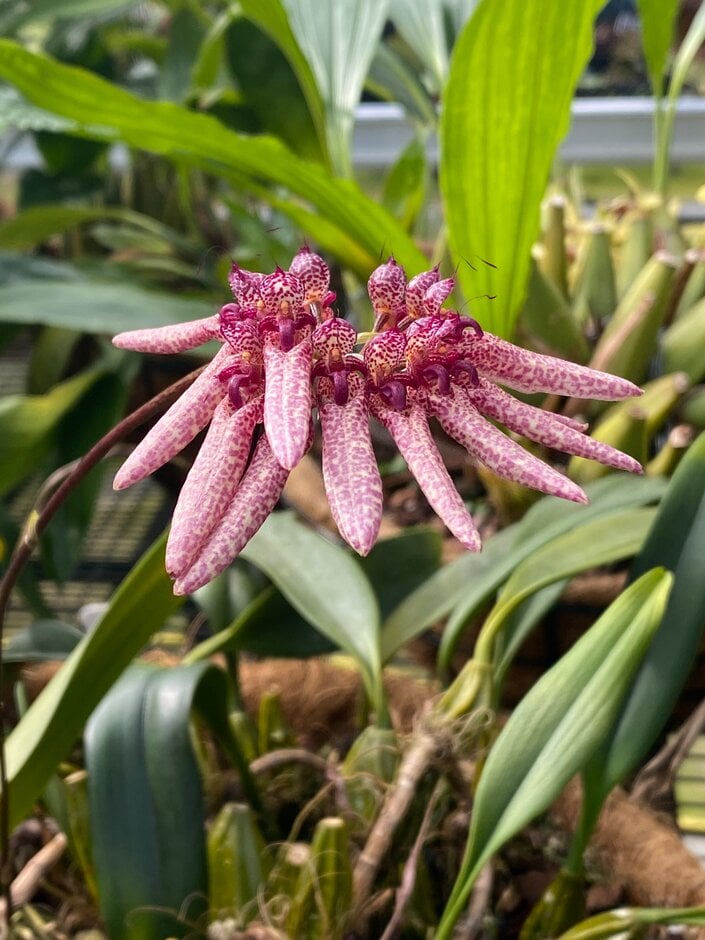Bulbophyllum Louis Sander gx
A warm to hot growing epiphytic orchid which is a hybrid of Bulbophyllum longissimum and Bulbophyllum ornatissimum, created by Sanders (St Albans) in 1936. The plant produces short, angled, egg-shaped green stems called pseudobulbs, which are adapted to store water and nutrients. The pseudobulbs arise from a creeping, rooting stem, and each are topped with a single, green, oblong to lance-shaped, leaf. Flowers are produced all through the year, in clusters at the end of thin stems and are pale pink with darker pink fine stripes. They are 8cm across. The upper sepal is somewhat hairy, while the lower sepals are 25cm long. The lip, an adapted petal evolved to attract pollinators, is tongue-shaped and yellow. They produce a slight but unpleasant, fetid smell

Size
Ultimate height
0.1–0.5 metresTime to ultimate height
2–5 yearsUltimate spread
0.1–0.5 metresGrowing conditions
Moisture
Moist but well–drainedpH
NeutralColour & scent
| Stem | Flower | Foliage | Fruit | |
| Spring | Green | Pink Yellow | Green | |
|---|---|---|---|---|
| Summer | Green | Pink Yellow | Green | |
| Autumn | Green | Pink Yellow | Green | |
| Winter | Green | Pink Yellow | Green |
Position
- Partial shade
Aspect
East–facing or North–facing or West–facing
Exposure
Sheltered Hardiness
H1ABotanical details
- Family
- Orchidaceae
- Native to GB / Ireland
- No
- Foliage
- Evergreen
- Habit
- Clump forming, Spreading branched
- Genus
A large, diverse genus of mainly epiphytic, sympodial tropical orchids, producing a clump of small pseudobulbs, which serve as plant’s storage for water and nutrients. Most species carry one leaf on top of each pseudobulb. Over 2000 species have been described and accepted
- Name status
Accepted
How to grow
Cultivation
Grow in an open, well drained but moisture-retentive mix of medium orchid bark, sphagnum moss and perlite. Shallow, wide pots or baskets are best used to accommodate its spreading habit. Bright filtered light is best as direct sunlight through glass can scorch its leaves. Prefers a minimum night temperature of 15°C and a maximum of 30°C in the daytime. Nighttime temperatures should be 10°C lower than daytime temperatures for good growth and is beneficial to induce flowering. High humidity is required along with gentle air movement. Allow plants to freely drain when watering and avoid plants sitting in water as this can cause roots to rot. Plants may be intolerant of hard tap water, so irrigate with rainwater at room temperature. Orchid fertiliser can be applied regularly throughout the growing season, March to September. Reduce watering and feeding in winter months. See indoor orchid cultivation for further advice
Propagation
Propagation by seed will not produce plants true to type as this is a hybrid cultivar. Mature plants may be divided when the plant overgrows its container. Each division should have at least 3 older pseudobulbs with a sufficient amount of stored energy and water, to support new growth and reduce stress after repotting
Suggested planting locations and garden types
- Conservatory and greenhouse
Pruning
No pruning required. Remove spent flower stem at the base
Pests
May be susceptible to mealybugs and scale insects
Diseases
Generally disease-free
Get involved
The Royal Horticultural Society is the UK’s leading gardening charity. We aim to enrich everyone’s life through plants, and make the UK a greener and more beautiful place.